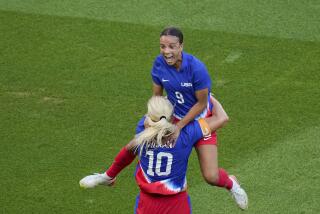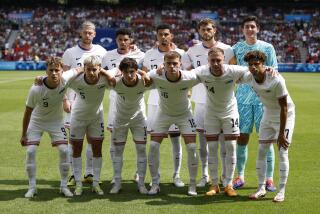U.S. Women Prepare to Defend World Cup Title
DAVIDSON, N.C. — The days of total anonymity are slowly disappearing for the women of American soccer. There are now network television commercials and major shoe endorsements. There are T-shirts and posters and videos.
When the players tried to get to the locker room following a 6-0 exhibition rout of Finland here Sunday, they were ambushed by dozens of autograph-seeking teen-age fans.
Fans who want to be like Mia, Michelle and Mary.
This is what is happening to the world’s best national women’s soccer team. This is what is happening to U.S. soccer’s greatest success story.
The American women will try to add another happy chapter next month at the Women’s World Cup in Sweden. They are the defending champions, having won the inaugural tournament in China in 1991, and they are favored to win it again.
“This is really different than ’91 because we were rookies at that World Cup,” said Michelle Akers, 29, a 5-foot-10 striker who has averaged nearly a goal a game in her 10-year U.S. career.
“Now we’re a little more in the spotlight and people know who we are. The rest of the world is gunning for us, and I really like it that way. It’s going to be a real challenge, a real test, on how tough we are mentally and how much we’re willing to give up in order to win. I really like these kinds of tests.”
Soccer, for the most part, belongs to the rest of the world. To Brazil and England and Germany and Italy. The U.S. men’s team is slowly gaining ground--an upset over Colombia in the World Cup’s first round, a respectable 1-0 elimination by Brazil in the second round, a handful of promising young players recruited to play overseas professionally.
But in the women’s game, the United States is the world leader.
It all started about 10 years ago when soccer’s world governing body, Federation Internationale de Football Association, decided to give the women’s game a push forward and make it competitive internationally.
“FIFA said, ‘Here’s the women’s game, you’re all at the same starting point, let’s see who can get to the finish line first,’ ” U.S. Coach Tony DiCicco said. “And the Americans did. That was great, but one finish line was not enough. We want to do it again.”
The U.S. Soccer Federation is taking the effort very seriously. The women’s team has been training on a full-time basis in central Florida since February and most of the players receive between $2,000 and $3,000 per month.
The squad has been to warmup tournaments in Portugal and France, and currently is on a Nike-sponsored U.S. tour that consists of games in Decatur, Ga.; Davidson; Tacoma, Wash.; Portland, Ore.; Dallas; and Edmonton.
DiCicco -- who replaced Anson Dorrance last August--announced his final 20-player roster this week. It includes nine veterans from the 1991 squad, five former University of North Carolina stars and one future Tar Heel--midfielder Tiffany Roberts, a high-school senior from California who will turn 18 on Friday.
The U.S. team will fly to Sweden on May 29, then play first-round games against China (June 6), Denmark (June 8) and Australia (June 10). The 12-team tournament will conclude with the championship game on June 18 in Stockholm.
ESPN2 will show all their first-round games, and the quarterfinal and semifinal if the team advances. ESPN will carry the final live.
The Americans’ toughest competition likely will come from 1991 runner-up Norway, Sweden and Germany.
But one of the reasons the U.S. team is favored is an attacking style that contradicts the way most teams--men’s or women’s--play. The Americans use three forwards, as opposed to one or two, and are always looking for goals.
Since the team began international competition in 1985, it has only been shut out 15 times in 107 games. Its all-time record is 74-26-7, including 20-2-1 the past 14 months. In qualifying for this year’s World Cup, the U.S. team outscored four opponents 36-1.
“Our style is attacking, no doubt about it,” said left wing Carin Gabarra, the team’s oldest player at 30. “We love to score goals. We like to win, but we like to win as big as we can. We’re not satisfied with just scoring one goal and then keeping the ball and relaxing and playing tight defense. We want to score more and more. That’s the whole American mentality.”
Said DiCicco: “There have been a lot of styles designed to prevent teams from scoring goals, and that’s fine. But that’s not our philosophy. We’re going to attack ... and we’re going to entertain the fans. To play a defensive game is a classic duel but it’s not very entertaining.”
The lightning-quick Gabarra was the most valuable player at the 1991 tournament. She has been the coach of the Naval Academy’s women’s team the past two seasons.
The hub of the attack is Akers, the leading scorer in the 1991 tournament who is recuperating from Epstein-Barr syndrome, a virus similar to mononucleosis that nearly ended her career two years ago. She has gradually regained her strength and says she’s “90 percent” healthy.
The other forward is Mia Hamm, 23, a graduate of North Carolina who made her first U.S. appearance when she was 15. Hamm started in midfield on the 1991 squad.
The team’s success has drawn enthusiastic crowds to its home games the past few years. Last week at a high-school stadium in Decatur, near Atlanta, more than 5,400 watched the U.S. squad beat Finland 2-0. The game at Davidson drew 3,300 -- a respectable count considering NBA star Michael Jordan was playing in nearby Charlotte.
“Everyone is focused on winning the World Cup,” midfielder Julie Foudy said. “We did in 1991 and we believe we can do it again. This team is capable of doing anything.”







